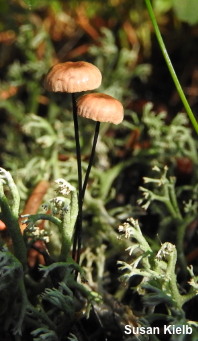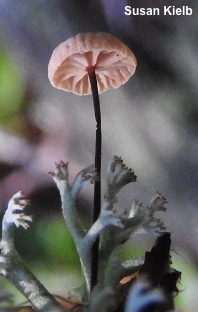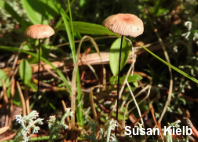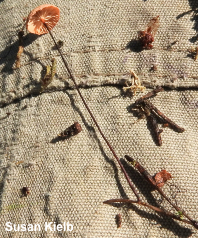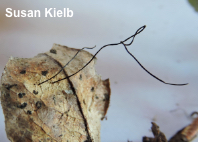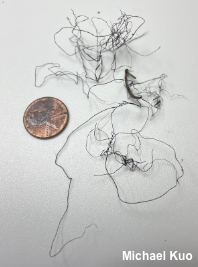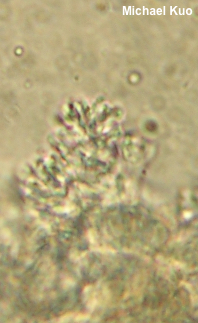| Major Groups > Gilled Mushrooms > Pale-Spored > Marasmioid > Gymnopus androsaceus |

|
Gymnopus androsaceus [ Basidiomycota > Agaricales > Omphalotaceae > Gymnopus . . . ] by Michael Kuo This tiny marasmioid mushroom appears on litter in conifer forests, primarily in northern and montane regions, and can be recognized by its dark and wiry stem, its pinkish gills, and its pinkish brown, widely pleated cap. The gills are broadly attached to the stem, rather than to a "collar," which helps to separate Gymnopus androsaceus from similar-but-collared species like Marasmius rotula. Another distinguishing feature of Gymnopus androsaceus is the copious black rhizomorphs attached to the base of the stem. The tiny, wiry cords spread through the duff, helping to decompose forest litter. Since the rhizomorphs are tough and long-lasting, many bird species prefer them as a component for nest building. The collection of Gymnopus androsaceus described and illustrated here, for example, was made in a northern Midwest jack pine forest where examination of palm warbler nests revealed consistent use of the rhizomorphs as nesting material. Micromphale perforans is similar, but reeks to high heaven (like rotten cabbage). Marasmius pallidocephalus has a paler cap, and differs microscopically. Gymnopus quercophilus is paler and decomposes the litter of hardwoods. Marasmius androsaceus is a previous name. Thanks to Susan Kielb for collecting, documenting, and preserving Gymnopus androsaceus for study; her collection is deposited in The Herbarium of Michael Kuo. Description: Ecology: Saprobic; growing gregariously on the litter of conifers or, more rarely, hardwoods; summer and fall, or over winter in warm climates; originally described from Sweden; widespread in Europe and western Asia; in North America widely distributed but more common in montane and northern regions; also reported from South Africa. The illustrated and described collection is from Michigan. Cap: 4–11 mm; convex, becoming broadly convex; dry; bald; pinkish brown to orangish brown or reddish brown, often fading so that the center is darker; broadly and shallowly grooved. Gills: Broadly attached to the stem; distant; with a few short-gills; pinkish. Stem: 2–7 cm long; up to 1 mm thick; equal; dry; wiry; dark reddish brown to black; with abundant black rhizomorphs attached to the base. Flesh: Insubstantial; pale brownish; unchanging when sliced. Odor and Taste: Not distinctive. Spore Print: White. Microscopic Features: Spores: 5–8 x 3.5–4.5 µm; subellipsoid to elongated-lacrymoid; smooth; hyaline in KOH; inamyloid. Basidia 20–30 x 4–7 µm; clavate; 4-sterigmate; basidioles fusiform to widely fusiform. Cheilocystidia as broom cells 10–20 x 6–8 µm; clavate to subclavate or somewhat irregular; with numerous rodlike or coralloid projections 1–3 µm long; thin-walled; hyaline in KOH. Pleurocystidia not found. Pileipellis of more or less cylindric elements mixed with coralloid, broom cell projections; elements smooth or encrusted in KOH; clamp connections present. REFERENCES: (Linnaeus, 1753) J. L. Mata & R. H. Petersen, 2004. (Kauffman, 1918; Gilliam, 1976; Phillips, 1981; Arora, 1986; Desjardin, 1987; Desjardin, 1989; Doyle & Sundberg, 1989; Breitenbach & Kränzlin, 1991; McFarland & Rimmer, 1996; Gordon & Petersen, 1997; Barron, 1999; Wilson & Desjardin, 2005; Mata, 2006; McNeil, 2006; Miller & Miller, 2006; Antonin & Noordeloos, 2010; Buczacki et al., 2012; Desjardin, Wood & stevens, 2015; Siegel & Schwarz, 2016; Baroni, 2017; Noordeloos, 2018; Elliott et al., 2019; Læssøe & Petersen, 2019; MacKinnon & Luther, 2021; McKnight et al., 2021.) Herb. Kuo 08162005. This site contains no information about the edibility or toxicity of mushrooms. |
© MushroomExpert.Com |
|
Cite this page as: Kuo, M. (2021, August). Gymnopus androsaceus. Retrieved from the MushroomExpert.Com Web site: http://www.mushroomexpert.com/gymnopus_androsaceus.html |
